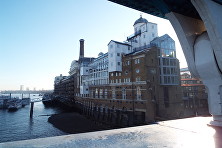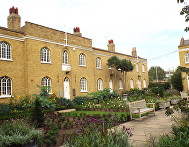





Exploring Southwark and discovering its history


The Bussey Building
The Bussey Building is a not very attractive but a sturdy old factory building, built alongside the railway tracks, in the heart of Peckham. Once the site of George Bussey & Co, a world renowned sports equipment manufacturer, it has in the twenty first century taken on a new lease of life as home to creative and vibrant artistic venues. The name will be familiar to those who only pass through Peckham on the train for at the top of the factory facing the railway lines is the painted sign GEO G BUSSEY & CO and a painted arrow that links SPORTS and GAMES through the initials GGB.
The building looms over the rest of the Copeland Industrial Park and is accessed through a narrow, covered passageway from the bustle of Rye Lane.
A Yorkshireman, George Gibson Bussey was born in 1829 and was apprenticed to a saddler. He moved to London in 1851 where he supplied leather gun cases and other shooting related items. Some time before 1870 he left premises in New Oxford Street and High Holborn and moved to Peckham where his business was described in a directory as “Firearms, Ammunition and Shooting Tackle Manufacturers.” Alongside the factory he owned a shooting range, a museum of firearms and a skating rink. George Bussey was very inventive and before long he had patented and was manufacturing a wide range of sports equipment that included roller skates, tennis rackets and balls, cricket bats, balls and stumps, and footballs. His products were of high quality and in demand internationally and today considered collectors’ items. The cricket bats were made from willow collected from Brookfield, Bussey’s country estate. The company’s most famous bat was called ‘The Demon Driver’ and they supplied bats to W G Grace, one of the most famous cricketers in the history of the sport. Among Bussey’s inventions was a gyro trap, a predecessor to clay pigeon shooting equipment, which saved living pigeons being used for target practice. Other inventions included a dining table that converted into a billiards table at a touch of a spring loaded switch and a device that enabled the golfer to practice his swings without the inconvenience of having to find and retrieve the golf balls.
Some reports say the factory burned down but whether due to a fire or not, a new factory, the existing building, was built in 1887. The architect was W J Easton.* George Bussey died in 1889, unsurprisingly a very rich man. His factory continued manufacturing until at least 1947.
By the early 21st century, the building was used as multi-occupier artists’ and design studios and small industries. In 2007 it was ear-marked to be demolished and the site set to become a tram depot for the proposed cross river tram service planned to run from Camden to Peckham and Brixton. A campaign, launched by Peckham Vision and the owner of the Copeland Industrial Park was launched and CLF, the Chronic Love Foundation, were involved in creating events to demonstrate how vital the Bussey Building was to the vibrancy and community life of Peckham. In the event, Transport for London announced in November 2008 the project would not go ahead after new mayor Boris Johnson announced a review in the absence of no central government funding.
Today the Bussey Building is home to a variety of activities that include artists’ studios, galleries, cafes, faith groups, yoga studios and designers. CLF have created the CLF Art Café which includes venues for theatre, music, stand-up and film. Safe from development, the Bussey Building now falls within the Peckham Conservation Area.
*Many thanks to Julie-Anne Lambert and Ian Jackson of the Ballam Collection of Games and Pastimes at the Bodleian Library, Oxford for passing on the name of the architect. It was gleaned from inside a box of table croquet manufactured around 1905 that is in their collection.
Entrance to the CLF Art cafe
Web discoveries
- UK Casino Not On Gamstop
- UK Casino Not On Gamstop
- Non Gamstop Casino
- Casinos Not On Gamstop
- Non Gamstop Casinos
- Non Gamstop Casinos
- Non Gamstop Casino
- Casinos Not On Gamstop
- Casino Sites Not On Gamstop
- Slots Not On Gamstop
- Casinos Not On Gamstop
- UK Betting Sites Not On Gamstop
- UK Casino Not On Gamstop
- Best Non Gamstop Casinos
- Betting Sites
- Non Gamstop Casino Sites UK
- Best Non Gamstop Casinos
- Non Gamstop Casino
- Casinos Not On Gamstop
- Non Gamstop Casino Sites UK
- Horse Racing Betting